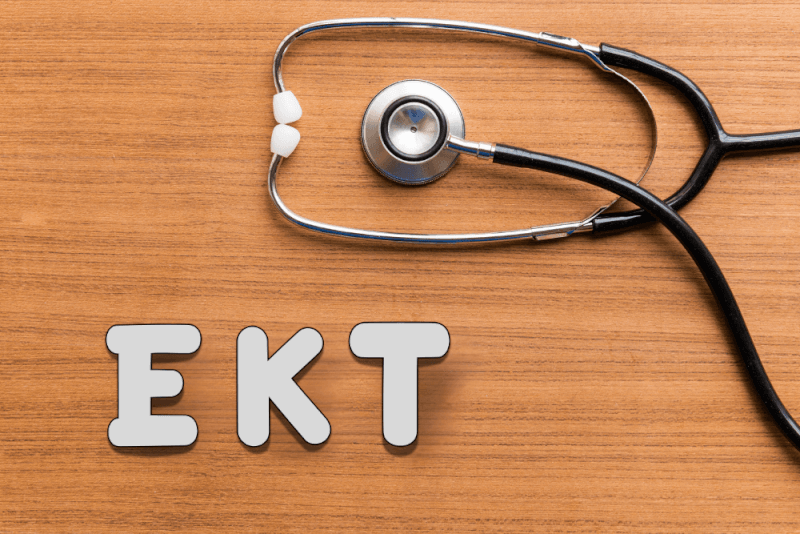30-Second Summary
- This medical procedure, performed under general anesthesia, involves passing a mild electric current through the brain to induce a brief seizure.
- The ECT procedure is carried out with the participation of multiple healthcare professionals, including an anesthesiologist, psychiatrist, and other trained staff.
- A significant portion of patients may regain consciousness within 10–15 minutes after the procedure and be able to stand and walk within 30 minutes.
- ECT provides significant and rapid improvement in the severe symptoms of various mental health conditions.
What is Electroconvulsive Therapy (ECT)?
This medical procedure, performed under general anesthesia, involves passing a mild electric current through the brain to induce a brief seizure. The main reason for applying ECT is to treat severe and treatment-resistant mental health disorders. Extensive studies conducted on this procedure, which has been in use for more than 80 years, show that it is an effective and safe method.
Anesthesia and Other Preparations
ECT procedures begin with general anesthesia that puts patients into a deep sleep and ensures that they do not feel any pain, discomfort, or anxiety during the procedure. In addition, providers inject a muscle relaxant to prevent any injury or strain that might occur during the seizure. A bite guard is placed in the mouth to protect the teeth, and an intravenous needle is inserted into one of the veins. The reason for establishing IV access is to allow medications to be quickly administered for anesthesia or to prevent any side effects.
Electrode Placement
Afterwards, specialists place electrodes on the scalp at contact points where the electric current will pass through. The placement areas are determined based on the specific needs of the patients. Additionally, the regions selected for electrode placement are those with the lowest risk
How is Electroconvulsive Therapy (ECT) Performed?
The ECT procedure is performed with the participation of multiple healthcare professionals, including an anesthesiologist, psychiatrist, and other trained personnel. The procedure consists of the following steps.
- In right unilateral placement, both electrodes are positioned on the right side of the head. One electrode is placed between the temple and the outer edge of the eyebrow. The other electrode is located just above the right ear, near the top of the head.
- In bifrontal placement, the electrodes are placed on the forehead just above the eyebrows.
- In bitemporal placement, one electrode is placed on each temple on both sides of the head.
Before placing the electrodes, a conductive gel is applied to prevent skin burning and irritation. Although the electric current used is low, skin burns and irritation may still occur.
Delivery of Electric Current
ECT procedures use electric currents of 0.4 amperes. Initially, specialists administer a lower level of electric current, gradually increasing it up to 0.4 amperes. The duration of the current delivery is very short. In many cases, the electric current is applied for only a few seconds.
Induction of Seizure
ECT uses electric current to induce a seizure when a burst of electrical activity occurs in the brain, causing the affected brain cells to fire rapidly. This results in electrical and chemical changes in the way that part of the brain functions, leading to improvements in its functioning.
Seizures caused by ECT usually last between 30 and 90 seconds. If they last longer, specialists can inject various medications to stop the seizure.
Post-Procedure
After the procedure is completed, specialists begin monitoring the patient. Vital signs are checked to detect any issues that may arise from the anesthesia or the procedure at an early stage. A significant number of patients may regain consciousness within 10–15 minutes after the procedure and be able to stand and walk within 30 minutes.
In What Situations is Electroconvulsive Therapy (ECT) Used?
ECT provides significant and rapid improvement in the severe symptoms of various mental health conditions, including the following:
- In patients with severe depression who also exhibit symptoms such as detachment from reality, strong suicidal urges, or failure to thrive
- Severe and treatment-resistant depression that does not improve with medications or other therapies
- Intense euphoria, agitation, or hyperactivity as part of severe mania and bipolar disorder. Other symptoms of mania may include impulsive or risky behavior, substance abuse, and psychosis.
- Catatonia, which includes symptoms such as lack of movement, rapid and strange movements, lack of speech, and others. It is associated with schizophrenia and certain other mental health conditions. In some cases, medical conditions may also cause catatonia.
- Agitation and aggression in dementia patients that are difficult to treat and negatively affect quality of life or pose a danger to others
In addition, ECT is recommended when patients are unable to take medications or do not respond to treatment. These situations include the following:
- During pregnancy, when medications may need to be used less frequently to reduce the risk of harm to the developing fetus
- In elderly individuals who cannot tolerate the side effects of medications
- In individuals who prefer ECT treatment over medication
- In patients for whom ECT has been effective in the past
Results of Electroconvulsive Therapy (ECT)
Patients can usually return to their normal activities within a few hours after the procedure. However, doctors recommend that patients refrain from returning to work, making important decisions, or driving for at least 24 hours after a single treatment or for one to two weeks after the final session or during maintenance therapy. Normal activities can resume if there is no memory loss or confusion.
A significant number of patients experience symptom improvement after about six treatments. More sessions may be necessary to achieve full recovery. Additionally, ECT may not work for all patients.
It is not exactly known how the method helps treat severe depression and other mental disorders. However, what is known is that the brain’s chemical composition changes during and after seizure activity. These changes build upon each other and can reduce the symptoms of severe mental illness. Therefore, ECT tends to yield better results after multiple treatments.
Even after symptoms have completely improved, it is necessary to continue depression treatment to prevent relapse. Moreover, ECT may need to be administered at longer intervals.
How to Prepare for Electroconvulsive Therapy (ECT)?
Before the ECT procedure, doctors will explain the procedures to the patient or guardian. It is also necessary to ensure that there are no existing health problems. Some tests need to be performed before ECT. The most commonly performed tests include the following:
- Blood and urine tests
- Imaging tests of the skull, brain, and spine
- ECG
What Are the Complications of Electroconvulsive Therapy (ECT)?
Although ECT is generally safe, it does carry some risks and side effects.
Confusion
Confusion may occur for a few minutes or hours after the treatment ends. Patients may not know where they are or why they are there. In rare cases, confusion may last for several days or longer. Confusion is more commonly observed in elderly patients.
Memory Loss
Some patients may have difficulty remembering events that occurred right before the treatment. Others may not remember weeks, months, or even years prior to the treatment. Forgetting years earlier is rare. This condition is called retrograde amnesia. In most patients, memory loss improves a few months after the treatment.
Physical Side Effects
On the days of ECT treatment, nausea, headache, jaw pain, or muscle aches may occur. These side effects can generally be treated with medication.
Medical Complications
As with any medical procedure, especially those involving anesthesia, there is a risk of developing medical complications. During ECT, heart rate and blood pressure may temporarily increase. ECT may be riskier in patients with serious heart conditions.
Advantages of Electroconvulsive Therapy (ECT)
ECT has many advantages that make it a critical tool in the treatment of mental health disorders.
Effectiveness
Experts agree that ECT is one of the most effective treatments for mood disorders such as depression. It is particularly effective for patients whose depression does not respond to medications or other forms of therapy.
Reliability
The use of anesthesia and other modern care practices has greatly increased the overall reliability of this procedure. Even people with heart conditions can often receive ECT with medication adjustments or close monitoring of vital signs.
Pregnancy
It can even be used in the treatment of patients during pregnancy. It does not harm the mother or the fetus and can be administered throughout the entire pregnancy period.
Rapid Action
People who undergo ECT often see improvements after 3–5 sessions, especially in cases such as major depressive disorder. This is especially useful when a severe mental health condition endangers a person's safety.
Helpful When Other Treatments Cannot Be Used
ECT can be administered to people who, for any reason, cannot take medications for mental health problems. This can make a difference for patients with organ function problems and pregnant women.
Effective When Used with Medications
People receiving ECT often also take medications for their treatment. This increases their chances of faster improvement in mental health.







